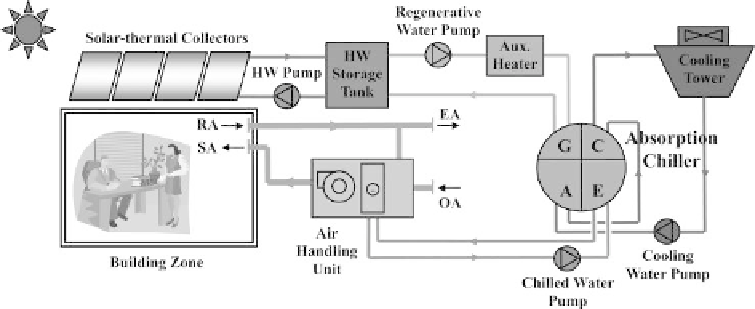Environmental Engineering Reference
In-Depth Information
Figure 15.2.2
Solar absorption refrigeration system for space conditioning. (Abbreviation:A: absorber;
C: condenser; E: evaporator; EA: exhaust air; G: generator; HW: hot water; OA: outdoor
air; RA: room air; and SA: supply air).
When the absorption chiller is operating, the cooling tower removes heat from both
the absorber and the condenser in series. The common working pairs are lithium bro-
mide/water and water/ammonia. For a typical single-effect LiBr-H
2
O absorption chiller
the driving temperature is generally between 70
◦
C and 90
◦
C, which can be primarily
achieved by solar-thermal gain, together with the assistance of auxiliary heating.
15.2.2.2 Solar adsorption refrigeration
Adsorption chillers have a relatively low driving temperature by using an appropriate
working pair of adsorbent and refrigerant. The schematic diagram of a solar adsorp-
tion refrigeration system is presented in Figure 15.2.3. Generally it is similar to that of
solar absorption refrigeration, except that an adsorption chiller is used. The econom-
ical adsorption pair is silica gel and water, where silica gel is the adsorbent and water
the refrigerant. Other effective adsorption pairs include zeolite/water and activated
carbon/ammonia. Compared to the absorption cycle, its driving temperature can be
down to about 60
◦
C. Typically, there are two chambers containing adsorbent in the
adsorption chiller. While one chamber is used for adsorption, the other is used for des-
orption. Their roles are interchanged according to the period of adsorption/desorption
process (usually 6 minutes for the silica gel/water pair). A pseudo-continuous operation
is therefore formed in the refrigeration cycle. Cooling water and regenerative water are
fed into the adsorption chamber and the desorption chamber respectively, and these
two water circuits are alternatively changed according to the role of the chamber.
15.2.2.3 Solar desiccant cooling
A solar desiccant cooling system can directly provide conditioned air to the building
zone, as shown in Figure 15.2.4. The core part of this system is the desiccant com-
ponent, and both solid and liquid sorbents, such as silica gel and lithium chloride
respectively, can be applied. Although desiccant cooling using liquid sorbent has the

Search WWH ::

Custom Search